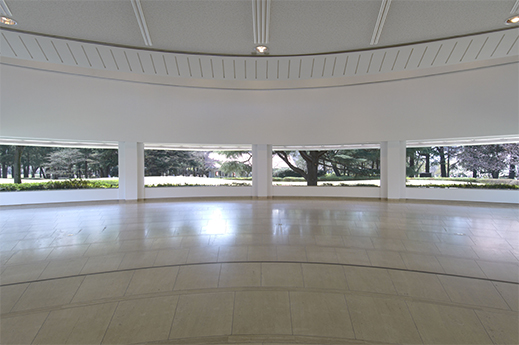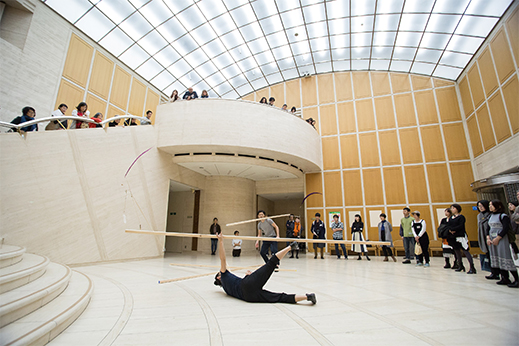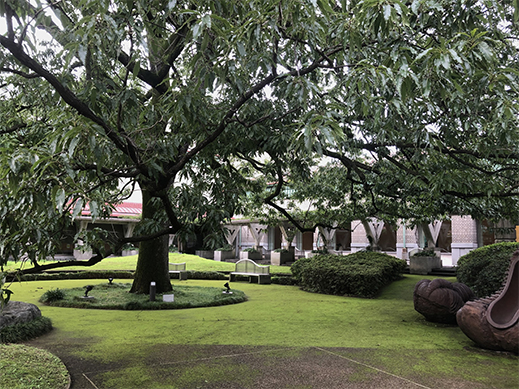 |
Focus features two in-depth reviews each month of fine art, architecture, and design exhibitions at art museums, galleries, and alternative spaces around Japan. |
|
|
 |
 |
 |
Galleries Without Artworks and Then Some at Setagaya Art Museum
Susan Rogers Chikuba |
 |
Setagaya Art Museum in Kinuta Park is a legacy work of architect Shozo Uchii. Its ample use of curved and horizontal elements and plentiful windows and plazas minimize the building's mass amid its natural surroundings. Photo by Susan Rogers Chikuba |
A community haven now more than ever, Setagaya Art Museum, or Setabi as it is affectionately known, sits near the central greensward of Kinuta Park that's bordered by a cycling course and popular with picnicking families. The coronavirus-inspired Galleries Without Artworks event now underway in its first-floor galleries through 27 August -- free of charge, offbeat, ad-hoc, ultimately pragmatic, and surprisingly successful -- means children can roam inside the space with few of the usual restraints, just as they do on the park's vast 96-acre grounds. For those who do want to see some art, 122 new additions to the permanent collection are on show upstairs until 16 August, an eclectic mix of works and media from the early 1900s to the present.
 |
|
Four huge windows, each nearly two meters high and more than five across, unite this gallery with the park outside, allowing passersby to enjoy the exhibits, too. It's an unusual feature for a museum built in the 1980s. Uchii received the Mainichi Art Award (1986) and Japan Art Academy Prize (1988) for this work. Photo courtesy of Setagaya Art Museum |
Architect Shozo Uchii (1933-2002) based his scheme on three key concepts: continuity with the park setting; an "open-system" design to support robust community engagement across multiple genres of art, including the stage arts; and the museum's appeal as a comfortable "living space" that invites visitors to linger. Cream-colored travertine softens the spaces throughout, as do rippling wave patterns in the ceilings, flooring, and handwoven wall coverings. Echoing those are the curved shapes of benches, chairbacks, and even the banisters -- in fact, Uchii designed all of the oak furniture and fittings in the museum. "People should want to reach out and touch the forms they see," he maintained, claiming that this is the quality that enlivens a design and makes it able to withstand the test of time.
|
 |
|
|
|
Families who come for Kinuta Park's cycling course, baseball and soccer fields, woods and wide-open lawns can social-distance safely while enjoying the architecture from inside the big empty galleries. Photo by Susan Rogers Chikuba
|
The dramatic passageway leading from the entrance hall to the first gallery is 25 meters of glass and travertine and bold triangles of articulated concrete. It is actually a bridge passing over a sunken patio where, to the right, people dine alfresco in the basement café. To the left, water falls audibly from a fountain cascade and trees dot a plaza where people relax on benches contoured to the landscape. Beyond lies a grassy knoll and then pathways through woods where joggers and strollers come and go.
With no art on display, the gaze in this fan-shaped gallery is drawn instead to the passersby outside -- a man carrying an infant in a snuggly, a woman and child on a bike, two colleagues opening their bento lunches -- and the multiple hues of green that are so rich in this season. A single majestic Himalayan cedar, moss-coated and multi-limbed under a bluish headdress of needles, stands like a goddess gesturing to the sky.
 |
|
"Normally only staff members get to see the room like this, with the windows uncovered and the partitions stowed," a curator told me as we stood, quietly awed, in this 360-square-meter hall. Though vast, it feels magically human-scale. Outside, behind Uchii's signature pergolas covered in fruit-bearing Staunton vines, stands the museum's unofficial symbol: a massive kunugi oak tree. Photo by Susan Rogers Chikuba |
While there are no artworks per se here on the first floor, there are a few exhibits. After these two empty galleries one enters a darkened alcove where a slideshow presents the posters for each of the 195 special exhibitions held from Setabi's inception up to the last one, scheduled for April but cancelled when the museum closed for two months. I don't often make it to this part of town, but so many eye-catching projects pulsed by, one after the other, that I found myself pledging to visit Setagaya more often. Farther ahead, a section entitled "Architecture, Nature, and Performance" recalls how the museum has upheld and interpreted Uchii's vision over the years.
 |
|
For a 2018 exhibition on Italian futurist Bruno Munari -- "the man who made useless machines" -- choreographer Luca Veggetti premiered a new work, Tanto quanto dura il soffio ("As long as the wind blows"). Performed by Yukio Suzuki and Hideaki Takeuchi, the dance began in the fan-shaped gallery and flowed across the bridge to conclude in the entrance hall. Photo by Teppei Hori |
Uchii's open-system concept called for all parts of the building -- the entrance hall, stairs, corridors, courtyard, and patios -- to be utilized for productions and installations. "Art cannot be isolated," he wrote. "It should be appreciated in a dynamic way, in the context of its relation to other things. Amid constantly shifting light and other conditions, even the noise and movement of people can heighten a work's beauty, showing it off to greater effect than the most meticulously designed space." The curators take this as their mission. From a full-scale ballet staged outside to performances by African percussion ensembles, a Korean samul nori band, and an experimental theater troupe, Setabi has mounted scores of diverse live events on its premises over the decades. Stills from 36 of them appear in another slideshow, while a 40-minute film projected on an opposite wall replays the interpretative dance and music composed for a Bruno Munari exhibition in 2018.
 |
|
A trio of undated works by avant-gardist and Informalist powerhouse Hideko Fukushima (1927-1997), and gold- and silver-leaf oil compositions by Kenji Yoshida (1924-2009), who studied in Paris under the abstract expressionist Stanley William Hayter and with Spanish sculptor Apel-les Fenosa, are just some of the eye candy that awaits upstairs in Intriguing Additions to the Collection. Photo by Susan Rogers Chikuba |
While the first-floor galleries are dedicated to special exhibitions, those on the second floor feature works from the permanent collection. Setabi owns some 16,000 pieces -- notably by Henri Rousseau and others representing the Naïve tradition, and artists connected in some way to Setagaya Ward. On show now are the latest acquisitions, made over the past six years. Anecdotal essays (in Japanese only) about their provenance are displayed for each of the 45 artists represented. Overall, the accounts read like a history of modern art in Japan from the dawn of the 20th century to the present.
Saburo Miyamoto's preparatory drawing for the Japan National Stadium mosaic "Faster," c. 1964. Photo courtesy of Setagaya Art Museum |
Among the new additions are a few works acquired in connection to the Olympic Games, including the above study by painter Saburo Miyamoto (1905-1974), who designed two wall mosaics (entitled "Faster" and "Higher") for the original National Stadium built in 1958. Miyamoto kept an atelier in Setagaya from 1935; his estate was donated to Setabi and is now one of three annexes the museum operates in the ward. His preparatory drawing for "Faster," rendered in oil pastels, sumi, watercolor, and graphite, was found in a poster tube wrapped around four more vintage works on display -- the series of official posters created by graphic designer Yusaku Kamekura (1915-1997) from 1961 onward for the 1964 Tokyo Games.
Five linocuts from Georges Wenger's "Magical Forest" series unite the "momentary glance" of photographic blueprints with the slow, concentrated labor of his print method. Photo by Susan Rogers Chikuba |
The Switzerland-based etcher and printmaker Georges Wenger (b. 1947) spent time in Kobe and Tokyo in the 1970s, and in 2008 began collaborating with calligraphers in Japan. At first glance his large-format prints of tangled twigs and underbrush seem like crisp black-and-white photographs. But in fact they are linocuts, rendered on Sekishu washi paper from Shimane Prefecture using a baren, the traditional flat-bottomed rubbing tool of woodblock printing. It doesn't seem possible that so many microtones of light and shadow can be teased out from such a method, but Wenger's arsenal of cutting and carving tools includes, it turns out, clusters of fine needles that he uses to achieve near-microscopic differentiations in tone. Each print can take several months to complete. "Form, or how the plant yields its fruit," he writes, "is the very essence of life and decay. I'm always delighted by this mysterious duet of nature and muse."
 |
|
Uchii's vision for the museum, Ars cum natura ad salutem conspirat ("Art and nature together nourish health"), is carved in the main entrance hall. A living symbol of that philosophy is this mighty kunugi oak. The courtyard in which it stands serves as an occasional exhibition and performance space. Photo by Susan Rogers Chikuba |
There's a lot more to Setabi than covered here. Check out its workshop spaces, educational programs, and library and video resources open to the public, the fancy Le Jardin restaurant, and Setabi Café, where you can kick back with a galette and a glass of Chardonnay, apple beer, or limoncello in the sunken courtyard. Its three annexes in different locations around the ward showcase the works of individual artists connected with those sites.
Stretch out with some art before or after a jog in Kinuta Park. Photo by Susan Rogers Chikuba |
Studies published in May by UNESCO and the International Council of Museums indicate that nearly 90 percent of the world's art institutions have seen temporary closures, and that some 13 percent may never reopen. Galleries Without Artworks itself is a kind of a happy fallout of hastily rejiggered exhibition schedules and renegotiated loan permissions. While there is no promise that Tokyo's experimental reopening from June will last, Setabi staff are following coronavirus protocol: separate entrance and exit routes have been established for traffic control, and a temperature check and contact-tracing questionnaire are administered upon entry. A mask or face covering is required, and visitors are asked to keep speech to a minimum inside the building. Admission to the permanent collection is just 200 yen. To keep this level of art accessible when we need it most, why not consider an annual membership -- 5,000 yen for adults (800 yen for students not yet in high school) covers entry to special exhibitions as well, and the three annexes, too.
All photo permissions are courtesy of Setagaya Art Museum. |
 |
 |
Susan Rogers Chikuba
Susan Rogers Chikuba, a Tokyo-based writer, editor and translator, has been following popular culture, architecture and design in Japan for three decades. She covers the country's travel, art, literary and culinary scenes for domestic and international publications. |
|
 |
|